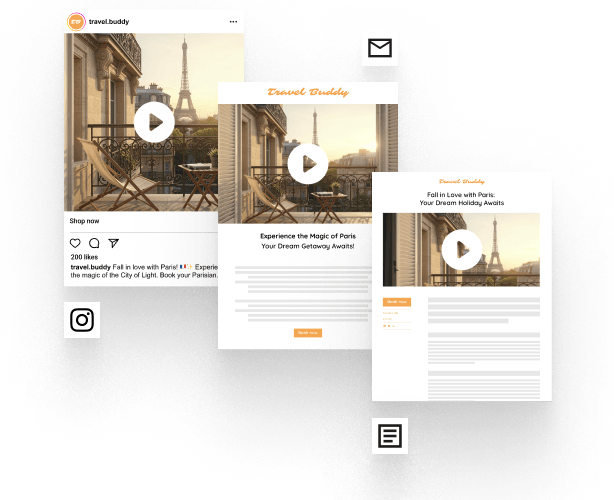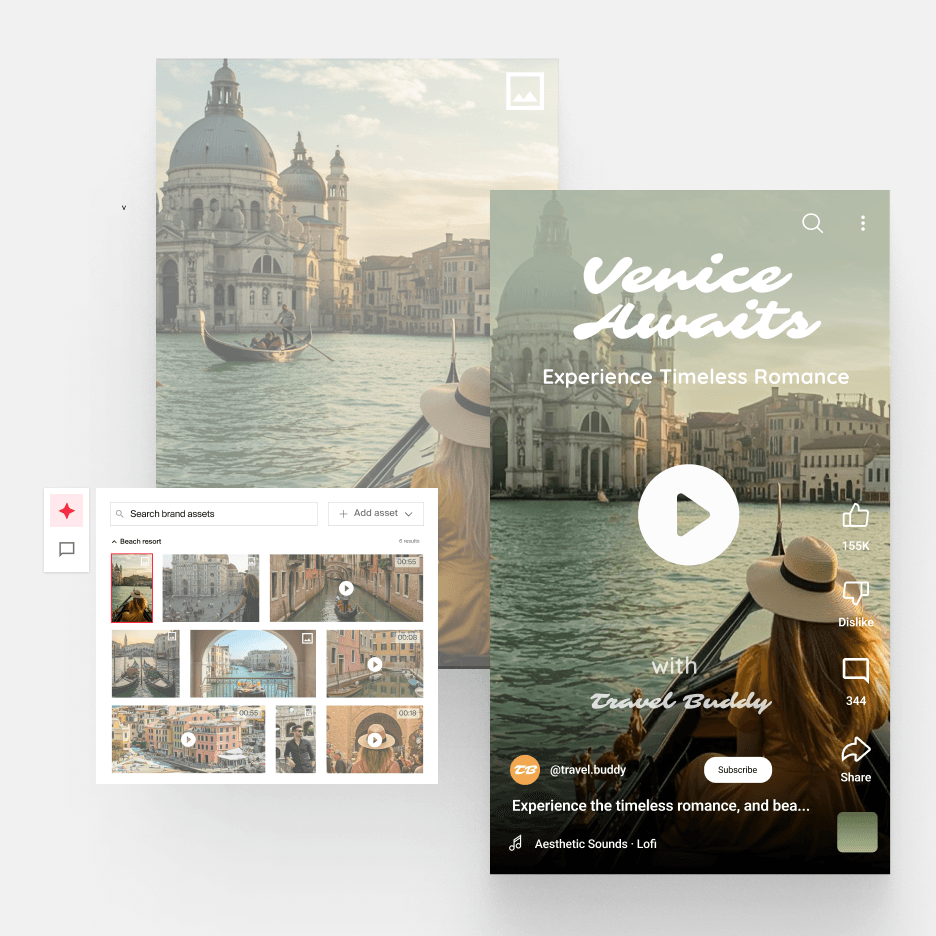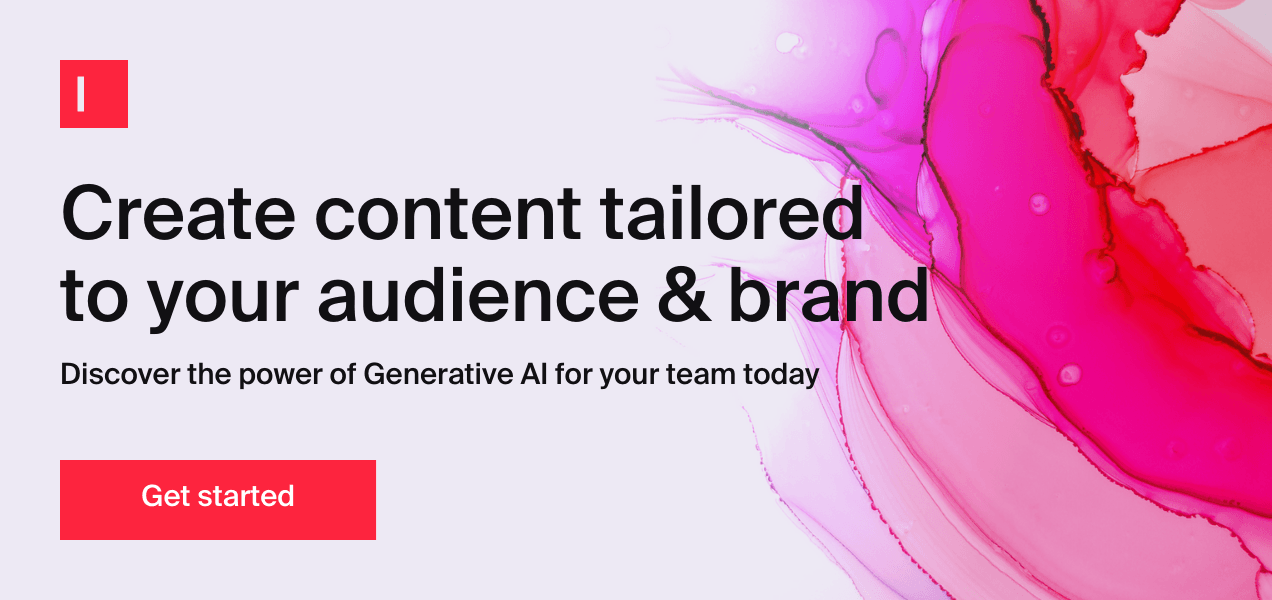AI at Work
Scaling Video Personalization with Agentic AI

Ashwini Pai · Senior Copywriter
August 30th, 2025 · 13 min read

Personalization in marketing is about providing the most relevant experience to a person (or cohort). It's often seen as marketing’s holy grail, because if you know the customer well, you can strike a chord through messaging that resonates with what they want or expect. That means the marketer’s job is to personalize their pitch well enough to spark interest and nudge action, whether that's completing a sale, building feel-good loyalty, or creating a deeper connection.
Although not a silver bullet — quality, reliability, value (and increasingly, sustainability) will always be top decision-drivers — personalization helps your message capture attention at every touchpoint throughout the customer journey. And while all marketing formats can be personalized, video personalization can drive stronger emotional connections through deep visual storytelling.
Given video's broad appeal and personalization's power to resonate, tailored video content can drive high engagement. Yet, personalizing video at scale has traditionally been complex and resource-intensive, requiring specialized skills and significant production time.
Agentic AI is changing that, transforming how brands approach personalization.
Intelligent AI systems that reason, act, and create much faster than humans can be guided to personalize content, especially at scale. And that even applies to video, with all its multiple creative dimensions.
Let's see how AI removes personalization limitations and gives your team the freedom to generate professional videos without motion graphics expertise.

What is video personalization?
Personalized video content has scenes and messages customized to the viewer’s needs, interests, or past activity. When your video speaks directly to your audience, they’re far more likely to pay attention and take the desired action — schedule a call, sign up for a free trial, or make another donation.
A video can be personalized to different levels:
Individual-level personalization for a 1-to-1 interaction. There are two main types:
A fully custom video made specially for the viewer or job role, when such a high-touch interaction can make all the difference. For example, sending a personalized video to a sales prospect, speaking to their challenges, goals, or recent news.
Because these videos are highly data-driven, they should be used judiciously to avoid coming across as intrusive or overly familiar.
Template-based personalization, where the same base video is used for everyone, and each individual viewer’s name, company, product, or location is inserted via text, voiceover, or overlays. AI or video automation tools are the practical choice for such at-scale video personalization. For example, a nonprofit director sends thank-you videos to major donors, mentioning their name, specific contribution, and its impact.
Segmented personalization considers cohorts rather than individuals. So, it’s broad but targeted (think account-based marketing, or ABM, in general terms). Most brands already personalize videos to audiences but aren�’t able to scale personalization to more segments due to the sheer effort and time it can take.
When should you invest in video personalization?
When you personalize content for key segments or customers, you’re hoping to create a positive experience for them, and that’s worth pursuing. From a practical standpoint, you also need to know whether personalization will improve outcomes enough to justify the investment. The answer will depend on your audience size, resource constraints, deal value or customer lifecycle value, or even your industry.
Decide if scalable video is right for you
Video customization should be on the table when you have a diverse audience with different needs and preferences. Driving engagement across multiple cohorts can be cumulatively more impactful than repeating the same message to everyone.
Generally speaking, video personalization at scale is most valuable for industries like retail, eCommerce, hospitality, B2B SaaS and enterprise sales, hospitality and travel, edtech, financial services, and non-profit.
At-scale video personalization is easier when you have a library of reusable assets: videos, images, graphics, product footage, etc. As today’s buyer moves quickly, scaling personalization by adapting what you have is the efficient alternative to creating separate videos for each segment from the ground up. AI makes repurposing existing assets into personalized videos even faster and easily achievable at high volumes.
How does video personalization work using Typeface?
Typeface is an AI marketing platform built for enterprise scale and compliance. It’s multi-modal, generating text, images, and videos to help marketing, sales, and HR teams create content faster without sacrificing brand integrity.
Content creation in Typeface
Three key components power Typeface's content creation approach:
AI agents
Specialized AI agents rapidly generate social posts, ads, emails, blogs, images (catalog, lifestyle, feature, and more), videos, and campaign concepts. Text summarization, content repurposing from one format to another (e.g., summarizing content from your YouTube video into an X thread), and brand compliance checks of content, are among other use cases.
Brand compliance
Typeface maintains brand voice, creative guidelines and compliance across AI generated content. One of the first steps when getting started with Typeface is training the AI on your brand's visuals and voice by providing sample content. These tones and visual styles are stored in your Brand Kit, which you can apply during AI generation for uniformly branded content.
Connected workflows
By integrating with your entire tech stack, Typeface makes content creation workflows smooth and elegant:
Typeface works across your asset libraries — whether in a DAM or another system — and your CDP (or CRM) for audience profiles and brand guidelines (editorial rules, tone, and compliant messaging). Pull brand-approved assets directly into your content generation to maintain personalized and compliant outputs.
Every AI-generated piece needs human review. With Typeface, this is effortless. Create workflows that automatically route content through copy, legal, and team reviews, with full customization to match your unique processes.
Connect your automation, review, and publishing platforms to deliver content across all channels as fast as you create it.
Collaborative workspace
Generate, edit, clip, and animate videos in your collaborative workspace Typeface Spaces. Bring team members in to boost collaboration and creative output.

Responsible and ethical AI
Typeface delivers enterprise-grade AI safety with strong controls, guidelines, and monitoring to mitigate misuse:
Our AI models block harmful prompts. Your data, prompts, and outputs remain private.
Our systems also review AI outputs and don’t display content that doesn’t pass our AI safety standards
Our implementation of the C2PA standard increases transparency and brand trust
Pro tips
Use Email Agent to generate personalized email variants, quickly scaling across multiple segments
Use Ad Agent to create personalized messaging and imagery for saved audiences within your brand's ad templates
How does Typeface personalize videos at scale?
Typeface’s Video Agent creates sizzle reels, short-form video, and video ads for your social media and paid marketing campaigns. It also resizes videos for different platforms, including TikTok, Meta, LinkedIn, and YouTube.
Video generation in Typeface follows simple steps. Provide the video generation prompt, guide the AI with inputs, and make quick edits using simple built-in tools, while AI handles the technical heavy lifting.
Generate a personalized sizzle reel from a brief
A sizzle reel (also called a highlight reel, sample reel, or demo reel) captures your brand’s best moments through fast-paced, lively video storytelling. Averaging 1-2 minutes in length, it can be repurposed from the videos you already have, for various marketing purposes, including audience personalization.
Example: If you're a travel company, you can instantly personalize sizzle reels for different types of travelers using the same destination videos. Highlight cliff jumps and treks for adventure seekers, serene retreats and nature views for wellness travelers, or historical sites and museums for cultural tourists, all with tailored visuals, voiceovers, music, and text.
Video creation steps:
State the goal of your video and themes or key messages, specifying the target audience. Optionally, upload a video brief.
Video Agent finds relevant existing clips and suggests a script. Accept or edit the script by simply describing the scene you want in a few words.
Customize the video
Select the video length and format (e.g., vertical TikTok)
Upload an audio clip to add music to your video
Specify the spoken or subtitled language, brand voice, and text styling
Generate the video
Make edits as needed. Change the text overlays to highlight key messages or include calls-to-action, add more effects, or adjust the transitions.
Download the video or add it to a content piece you created in Typeface.
Auto-resize videos for different platforms
Creative automation is a time-saving AI technique for auto-resizing images and videos for different placements and platforms. AI can crop videos and adjust aspect ratios to fit requirements while ensuring visual focus on important elements of a scene. When generating scores of visual assets, creative automation frees your team to focus on storytelling instead of being bogged down by repetitive workflows.
With Video Agent, you can adapt video size by simply selecting the required dimensions (9:16, 4:5, 1:1, and more), meeting the demand for faster, multi-format content delivery. Generate multiple campaign videos and audience-personalized variations from one workflow. Scale to any number of multi-lingual, multi-market assets without extending timelines or budgets.

Animate still shots
AI can animate static images by adding motion, layering dynamic text or overlays, simulating camera movement, animating lighting, and adding ambient effects. Generating multiple ad variants this way is easy: in simple words, tell AI how to animate the video and choose the required video format and duration. You can personalize the video with tailored visuals, text, offers, voiceovers, or calls to action, based on your audience segment.
Example: Animate a static product image, like a pair of sneakers, by adding a rotating price tag. Create a relevant CTA for budget-minded shoppers. A different product, say, high-end leather sneakers, can be animated with premium cues. Get more out of what you already have, with no manual design or reformatting.
Break down long-form content for new formats
Video Agent can trim your 5-minute destination video into bite-sized, platform-ready formats. You can create TikTok-style clips, a 30-second YouTube pre-roll ad, or a series of Instagram Stories from the same content, tailored for every channel.

Localize for regions or languages
Swap voiceovers into different languages and adjust currencies, offers, or booking URLs. Whether your viewer is in the Middle East or Australia, the message will feel accessible and relevant.
Also consider:
Videos welcoming team members and celebrating employee work anniversaries and business milestones
Personalized sales and marketing videos for targeted outreach
Micro demos tailored to specific prospects
ABM videos addressing individual accounts
Webinar and event invite videos
Getting personalization at scale right: Key factors to consider
Personalization depends on a deep understanding of the customer. A single source of truth for customer data is a prerequisite to effective personalization. Even so, you may not have the information you need to create truly personalized experiences. Start by auditing your existing data to see what's missing and keep your data clean and consistent.
Keep in mind that you may never know the customers as well as you'd like, since under GDPR and CCPA, they can request their data be anonymized. This personalization-privacy paradox must be handled thoughtfully, remembering that customer trust matters above all else.
Further, departmental siloes can hinder personalization just as must as fragmented data. If marketing and sales are sending the same person different messages, it can confuse the customer and make your organization look disorganized. When your whole team is on the same page and communicating the same value, personalized content becomes more powerful and persuasive.
Create personalized videos at enterprise scale
Video personalization is a great strategy to cut through the noise, but complex, even for enterprises. AI Agents guided by your team speed up content creation for each cohort, ensuring personalized experiences are delivered consistently across touchpoints. Agentic workflows automate repetitive manual tasks, streamlining content development and driving greater focus on strategy and storytelling.
Typeface’s agentic AI is designed to meet the video personalization and volume needs of enterprises creating for multiple cohorts and markets. A strong AI safety framework, adaptable workflows, and integration with enterprise martech keep creative output compliant, consistent, and ready to scale.
Speak to every customer without limitations. Start with a demo or contact sales.
FAQs
1. How can I ensure brand safety when using AI for video personalization?
Use an AI marketing platform that keeps your data, prompts, and outputs private, and generates outputs aligned with your brand guidelines. These are responsible AI (RAI) practices, which Typeface implements across our workflows. All outputs follow your brand kit (animations, fonts, logos, and voice style), and your data is not shared with third parties or models. This apart, human oversight in data management is essential to ensure brand safety.
2. Can Typeface integrate with existing video production tools?
Typeface works across your marketing tech stack, including your image and video editing software. It can support tailored workflows for large-scale operations. Our developer document has all the information.
3. What metrics should be used to measure the success of personalized video campaigns using AI?
These are the key performance indicators to monitor:
Engagement rates (e.g. view duration and clickthrough rates)
Conversion rates compared to non-personalized videos
Brand recall and sentiment metrics
Production efficiency
Campaign effectiveness

Share
Related articles

AI at Work
How to Use AI to Repurpose Videos into Blogs, Emails, and Social Posts

Akshita Sharma · Content Marketing Associate
June 17th, 2025 · 8 min read

AI at Work
Scaling Video Content: Unlock Your Content Library with AI-powered Search and Repurposing

Ashwini Pai · Senior Copywriter
June 17th, 2025 · 8 min read

AI at Work
40 AI Summary Prompts to Summarize Videos, Text, and Podcasts

Ashwini Pai · Senior Copywriter
November 11th, 2025 · 14 min read